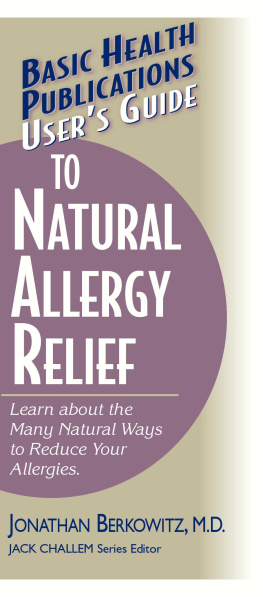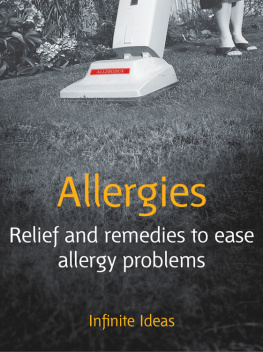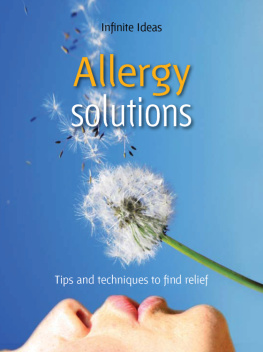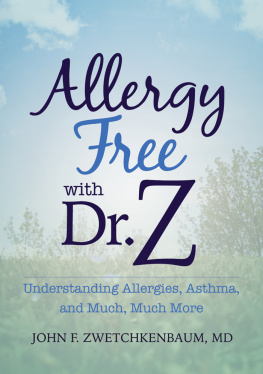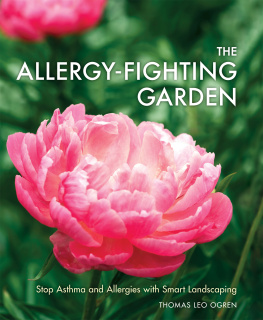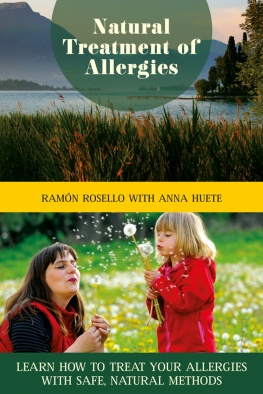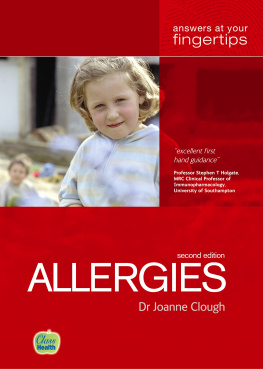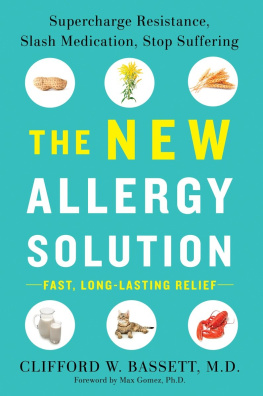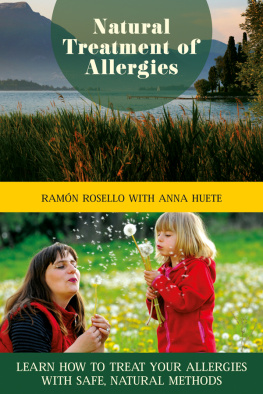CHAPTER 1
ALLERGY FACTS
T he word allergy has different meanings for different people, but for most, it means seasonal hay fever, those fits of sneezing and runny nose that occur during predictable times of the year, such as spring or fall. For others, the word means a food or drug allergy characterized by a rash when, for example, ingesting a certain medication, or by diarrhea after eating a particular food. Some people may know exactly what triggers their allergies while, for others, the cause of their misery remains a mystery. Allergies, like people, come in all shapes and sizes, but for the vast majority of people, allergies begin with the nose.
From a functional standpoint, the nose helps us breathe, warm, moisturize, and filter air before it reaches our tender lungs. The word allergen is a medical term for a particle that can cause an allergic reaction. Allergens vary from person to person and can range from pollen to food additives. For the vast majority of people, however, allergens are airborne, and it is when an allergen is trapped inside the nose that our troubles begin.
Allergen
Generic term for any inhaled or ingested particle (dander, food coloring, pollen, etc.) that can trigger an allergic reaction. The words allergen and antigen are often interchangeable.
Let us take a moment to examine the word allergen. One of the important roles of the bodys immune system is to identify self from non-self. Self is what belongs to us: the cells, organs, and tissues that make up our bodies. Non-self includes the rest of the world that is not a natural part of our bodies and can include bacteria, viruses, food, and pollen; it is also referred to as allergens or antigens. The immune systems ability to differentiate self from non-self is obviously important, as antigens can represent dangerous organisms like bacteria or fungi. Most any substance can act as an antigen/allergen, but the body usually reacts hostilely only to antigens it considers harmful. This hostile reaction starts with the bodys formation of antibodies, which are proteins that bind to antigens and alert the immune system that a potentially dangerous invader is present.
Antigen
Any molecule (for example, pollen) that can interact with the immune system and trigger a response, such as an allergic reaction.
While these antibodies are found throughout the body, for allergic people it is the antibodies residing in the nose and lungs that cause the most trouble. The nose and lungs are covered by a lining called respiratory epithelium that harbors many different cells and proteins, such as immunoglobulins and mast cells. Immunoglobulins are those protein antibodies that act like sentries, recognizing allergens and binding to them. Our tissues contain millions of individual antibodies that are specially manufactured to recognize a specific antigen. For instance, we have antibodies that recognize only the influenza virus. We have other antibodies that recognize only certain types of fungi. Whether or not a person develops an immune or allergic reaction to an antigen depends on whether or not they have antibodies specific for that antigen. Virtually every person on Earth has antibodies to the influenza virus, for example, but not to ragweed, which explains why some people are allergic to ragweed and others are not.
Antibody
An immune-system protein that binds to a specific allergen or antigen, and can trigger an allergic reaction. The chief antibody of the allergic response is immunoglobulin E (IgE).
Immunoglobulin
Protein central to immune-system response, including the allergic reaction, responsible for binding and identifying potential allergic triggers.
Say, for instance, you inhale a virus. The virus has antigens on its surface that help it attach to the respiratory epithelium and allow it to be recognized by an immunoglobulin specifically designed for that virus. When the immunoglobulin binds to the virus, an antibody-antigen interaction occurs that, in turn, sounds the alarm. Once the alarm is sounded, natural killer (NK) cells rush in and decimate the invading virus.
Now, where do mast cells and allergies fit into this antibody-antigen interaction? Mast cells belong to the immune system and, when stimulated, release chemicals like histamine that cause allergy symptoms. Of all the allergy-related cells, the mast cells are the ones most responsible for the allergic response, and are to blame for up to half of all allergy symptoms. Even worse, mast cells spread the message to other immune system cells, such as basophils, eosinophils, and leukocytes, to make them aware that an allergen is present. As for antibodies, the chief antibody of the allergic response is immunoglobulin E (IgE). It is the job of IgE to recognize and form an antibody-antigen interaction with allergens like pollen and dander.
Histamine
The most important chemical mediator of the allergic response, responsible for the majority of allergy symptoms.
As an example of how this works, lets say you have an allergy to cats. You inhale some cat dander that attaches to the respiratory epithelium of your nose where it is recognized and bound in an antigen-antibody interaction by IgE that is specific to cat dander. Once this antibody-antigen interaction occurs, the IgE lets the the local mast-cell population know what it has found. Then, once the mast cells know that there is an allergen present, they panic and send out the alarm to the basophil, eosinophil, and neutrophil cells, which, in turn, release or aid in the release of histamine, prostaglandin-2, and leukotrienes, all chemical mediators (substances) that cause sneezing, coughing, and runny nose. Bottom line? You feel miserable!
Leukocytes
Synonymous with white blood cells, this is a general term for any white cell that belongs to the immune system.
The concept of chemical mediators is important because the most successful allergy therapies block such inflammatory substances as histamine and leukotriene, thereby blunting or eliminating the allergic response. Many allergic reactions have two phases: an immediate phase and a delayed phase. The majority of allergic reactions occur immediately after exposure to a specific allergen, but a delayed allergic reaction can occur two to eight hours after exposure, resulting in chronic symptoms. In the first phase of the immediate reaction, the mast cells release histamine, but in the second delayed phase, basophils release most of the histamine. In both cases, the histamine binds to special H1 receptors that, in turn, create the signals necessary for allergy symptoms to appear.
Leukotrienes
Derived from arachidonic acid, these are the chief chemical mediators of the inflammatory and allergic reactions.
Unlike natural killer (NK) cells, whose primary mission is to destroy invading bacteria, the basophils and mast cells cause you to cough, sneeze, and drip, which is their way of helping to remove the offending allergen from your body. With food allergies, these same cells may cause diarrhea, which speeds up the removal of the irritating food. Not all antigens, however, cause an allergic reaction in a person. It will only be those allergens that a particular individual is sensitive to that will cause an allergic reaction to occur.
H1 Receptor
Binding site found on a cell membrane that specifically binds to histamine, resulting in a cellular or allergic reaction.
Now, just exactly what is an allergic reaction? Like allergens, allergic reactions vary from person to person, depending on how allergic they are. Some people have mild allergies characterized by a rare sneeze. Other people have severe allergies that cause persistent sneezing, coughing, headache, and runny nose. Other people have a skin reaction characterized by hives, a rash, or eczema. There is even an extreme allergic reaction called anaphylaxis that can cause potentially life-threatening airway obstruction. Mercifully, anaphylaxis is exceedingly rare and most of those with allergies are merely miserable.
Next page
